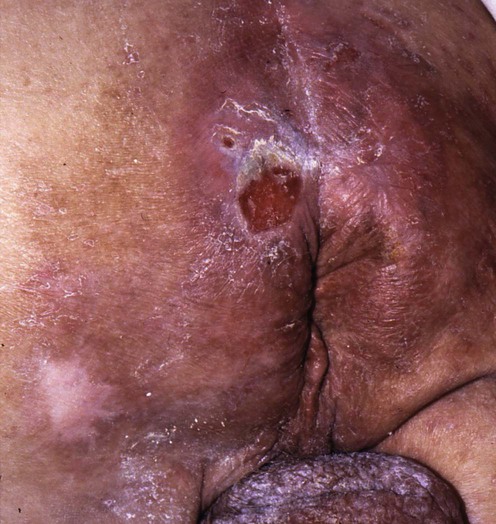Decubitus ulcers
Joseph A. Witkowski, Lawrence Charles Parish, Caren Campbell and Jennifer L. Parish

Management strategy
Prevention
General measures
 Saline should be used to clean most pressure lesions; soap and disinfectants are too irritating for more than occasional use.
Saline should be used to clean most pressure lesions; soap and disinfectants are too irritating for more than occasional use.
 When ulcers are not infected, synthetic dressings should be changed only if they become dislodged or wound fluid escapes from under the dressing.
When ulcers are not infected, synthetic dressings should be changed only if they become dislodged or wound fluid escapes from under the dressing.
 Periulcer skin must be kept dry not only to avoid maceration but also to permit the dressing to adhere to the skin.
Periulcer skin must be kept dry not only to avoid maceration but also to permit the dressing to adhere to the skin.
 To obliterate dead space, fill deep ulcers loosely with a hydrocolloid, a hydrogel wound filler, or an alginate rope before applying a synthetic dressing. This same material should be placed under the edge of the ulcer when undermining is present. Bleeding after serial surgical debridement can often be controlled with an alginate dressing; the calcium alginate assists in the clotting pathway. Moistening with saline can loosen an alginate dressing that adheres to granulation tissue.
To obliterate dead space, fill deep ulcers loosely with a hydrocolloid, a hydrogel wound filler, or an alginate rope before applying a synthetic dressing. This same material should be placed under the edge of the ulcer when undermining is present. Bleeding after serial surgical debridement can often be controlled with an alginate dressing; the calcium alginate assists in the clotting pathway. Moistening with saline can loosen an alginate dressing that adheres to granulation tissue.
 A clean ulcer failing to show signs of healing, or an ulcer with persistent excessive exudate, should be treated with antibacterial agents, e.g., 1% silver sulfadiazine, cadexomer iodine, triple antibiotic, or retapamulin, for 2 weeks to reduce the bacterial burden. Increased bacterial burden may impede healing before clinical signs of infection become apparent. The odor of an infected ulcer can often be eliminated by applying metronidazole gel to the ulcer bed. Systemic antimicrobial agents are indicated for patients with bacteremia, sepsis, advancing cellulitis, or osteomyelitis.
A clean ulcer failing to show signs of healing, or an ulcer with persistent excessive exudate, should be treated with antibacterial agents, e.g., 1% silver sulfadiazine, cadexomer iodine, triple antibiotic, or retapamulin, for 2 weeks to reduce the bacterial burden. Increased bacterial burden may impede healing before clinical signs of infection become apparent. The odor of an infected ulcer can often be eliminated by applying metronidazole gel to the ulcer bed. Systemic antimicrobial agents are indicated for patients with bacteremia, sepsis, advancing cellulitis, or osteomyelitis.
 Although most synthetic dressings relieve pain, treatment for moderate to severe pain can include topical anesthetics, non-steroidal anti-inflammatory drugs (NSAIDs), opiates, antidepressants, and sedatives. Many patients with decubitus ulcers do not have pain.
Although most synthetic dressings relieve pain, treatment for moderate to severe pain can include topical anesthetics, non-steroidal anti-inflammatory drugs (NSAIDs), opiates, antidepressants, and sedatives. Many patients with decubitus ulcers do not have pain.
Specific investigations
Categories of patient
Patients at risk need to be considered in terms of the underlying disease process:
 Spinal cord injury in an otherwise healthy person
Spinal cord injury in an otherwise healthy person
 Neurologic disease with no medical disease, but a devastating condition such as multiple sclerosis or a cerebral vascular accident compromising the body integrity
Neurologic disease with no medical disease, but a devastating condition such as multiple sclerosis or a cerebral vascular accident compromising the body integrity
 Debilitation with a multitude of medical diseases affecting the patient (e.g., arteriosclerosis, diabetes mellitus, Parkinson’s disease, Alzheimer’s disease, malignancy, malnutrition, and peripheral vascular disease)
Debilitation with a multitude of medical diseases affecting the patient (e.g., arteriosclerosis, diabetes mellitus, Parkinson’s disease, Alzheimer’s disease, malignancy, malnutrition, and peripheral vascular disease)
 Surgical procedures requiring lengthy positioning on the operating table for cardiovascular or orthopedic procedures
Surgical procedures requiring lengthy positioning on the operating table for cardiovascular or orthopedic procedures
Staging
 Stage I: non-blanchable erythema of intact skin
Stage I: non-blanchable erythema of intact skin
 Stage II: partial-thickness skin loss involving the epidermis and/or dermis
Stage II: partial-thickness skin loss involving the epidermis and/or dermis
 Stage III: full-thickness skin loss with damage to the subcutaneous tissue that may extend down to, but not through the underlying fascia
Stage III: full-thickness skin loss with damage to the subcutaneous tissue that may extend down to, but not through the underlying fascia
 Stage IV: full-thickness skin loss with extensive destruction, tissue necrosis, or damage to muscle, bone, or supporting structures
Stage IV: full-thickness skin loss with extensive destruction, tissue necrosis, or damage to muscle, bone, or supporting structures
First-line therapies
Eliminating pressure and relieving devices
Debridement
Pressure ulcer treatment guide: quick reference guide for clinicians No. 15.
Bergstrom N, Bennett MA, Carlson CE. Adv Wound Care 1995; 6: 22–44.
Histologic examination of bone biopsy specimens is the gold standard for diagnosing osteomyelitis.
More effective removal of debris can be accomplished by twice-daily wound treatment.
















 Elimination of pressure
Elimination of pressure Pressure-reducing and -relieving devices
Pressure-reducing and -relieving devices Removal of necrotic debris
Removal of necrotic debris Maintenance of a moist wound environment
Maintenance of a moist wound environment Synthetic dressings
Synthetic dressings Topical antibacterials
Topical antibacterials Nutrition
Nutrition Dietary supplements
Dietary supplements Hydrocolloid wafer dressing
Hydrocolloid wafer dressing Nitroglycerin ointment
Nitroglycerin ointment Becaplermin gel
Becaplermin gel 5-Fluorouracil cream
5-Fluorouracil cream Hyperbaric oxygen
Hyperbaric oxygen